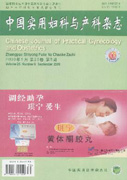Abstract: Objective To investigate the prognostic factors of uterine sarcomas and to improve its survival rate.Methods One hundred and one patients with uterine sarcoma from Department of Gynecology,Liaoning Cancer Hospital,China were retrospectively reviewed from 1984 to 2008.Results The overall 5-year survival rate was 46.5%. Univariate analysis showed that:patients under 52 had a better survival rate than those over 52 (χ2=5.915,P=0.003).Premenopausal patients’5-year survival rate was 57.6%, while postmenopausal patients’ was 25.7%(χ2=9.332,P=0.002 ). The 5-year survival rate of leiomyosarcoma was 34.3%, mixed mesodermal tumors was 16.7%, and endometrial stromal sarcoma was 73.8%(χ2=23.274,P<0.001).The 5-year survival rates of StageⅠ,Ⅱ,Ⅲand Ⅳ were 61.1%, 36.4%, 18.2% and 0%,respectively (χ2=9.428, P=0.009). When uterine volume was less than 3 months of pregnancy uterine size, the 5-year survival rate was 65.2%, while for greater than 3 months’it was 41.0% (χ2=4.178,P=0.041).The 5-year survival rates of surgery,surgery+ radiotherapy + chemotherapy, surgery + chemotherapy, surgery and radiotherapy were 41.7%,62.5%,45.9% and 44.4% (χ2=4.390,P=0.375).The prognostic factors based on multivariate analysis were menopause status ,surgical staging,and histological type. Surgical staging was the most significant prognostic factor(P=0.001).Conclusion The prognosis of uterine sarcoma is significantly related with menopause status , surgical staging and histological type.

